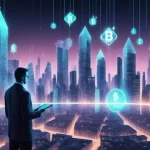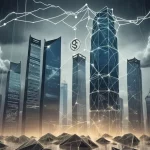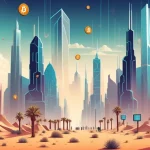RWA Tokens Surge: Bridging TradFi and DeFi, Unlocking Trillions

The Rise of RWA Tokens: Unlocking Trillions in Traditional Markets
Real World Asset (RWA) tokens are revolutionizing the investment landscape by bridging traditional assets like real estate and art with blockchain technology. This integration promises to unlock trillions in value from markets that were once considered illiquid or exclusive.
- RWA tokens represent traditional assets on blockchain
- They aim to increase liquidity and accessibility
- Potential to unlock trillions in value
- Challenges include regulatory hurdles and trust issues
RWA tokens are digital representations of physical or traditional assets, such as real estate, art, commodities, and bonds, recorded on a blockchain, a secure digital ledger. By converting these assets into digital tokens that can be bought and sold easily, RWA tokens are poised to bridge the gap between traditional finance (TradFi) and decentralized finance (DeFi). Imagine you’re a young investor with $1,000. With RWA tokens, you could own a piece of a skyscraper in Manhattan or a slice of a Van Gogh painting without worrying about where to hang it.
The democratization of asset ownership is not just exciting; it’s revolutionary. Traditionally, investing in property has been a cumbersome process, often requiring large sums of money and patience. But with RWA tokens, you can buy a fraction of a property, allowing even those with limited funds to dip their toes into real estate investment. It’s like turning the key to a treasure chest that was previously locked away from the masses.
However, the journey isn’t without its challenges. Regulatory uncertainty looms large as governments and financial regulators grapple with how to oversee these new financial instruments. Additionally, establishing trust in tokenized assets is paramount. After all, who wants to invest in a digital token if they’re not sure it’s backed by a real, tangible asset? While RWA tokens promise to democratize investment, we must be wary of potential scams and overhyped projects.
Despite these hurdles, the potential impact of RWA tokens on the broader cryptocurrency ecosystem is undeniable. They could bring more traditional assets into the fold, increasing the diversity of assets available on blockchain platforms and potentially attracting more traditional investors to the space. But this also raises questions about the balance between decentralization and the integration of traditional financial systems. Are we moving towards a future where the lines between TradFi and DeFi blur, or will RWA tokens simply become another tool in the financial arsenal?
Projects like Chainlink, Mantra, and Ondo Finance are at the forefront of the RWA token space, providing the infrastructure needed to tokenize various assets. Smart contracts, which are self-executing contracts with the terms directly written into code, automate transactions and ensure compliance, making the process more efficient and secure. However, the road to widespread adoption will be slow, as compliance issues and the need for robust legal frameworks continue to pose challenges.
To create an RWA token, the asset is first appraised and then divided into digital tokens, each representing a fraction of the asset. These tokens are then recorded on a blockchain, ensuring transparency and security. Platforms like Ethereum, Polymath, and RealT facilitate this process, offering the necessary tools for creating and managing tokenized assets.
Case Studies
Consider the example of real estate tokenization. Platforms like RealT allow investors to buy tokens representing ownership in properties, enabling fractional ownership and increasing liquidity. Similarly, art tokenization through platforms like Maecenas lets investors own shares in high-value artworks, making it accessible to a broader audience.
Another case is the tokenization of commodities by projects like Digix, which tokenizes gold, allowing investors to own and trade digital representations of physical gold. These examples highlight the practical applications of RWA tokens and their potential to transform traditional markets.
Future Outlook
The global asset tokenization market is projected to reach $4 trillion by 2025, indicating significant growth potential. As blockchain technology continues to evolve, new platforms and regulatory frameworks will emerge, further facilitating the adoption of RWA tokens. However, as with any emerging technology, the road ahead will be fraught with challenges and opportunities. As we navigate this new frontier, one thing is clear: RWA tokens are not just a trend; they’re a fundamental shift in how we think about ownership and investment in the digital age.
“RWA tokens are poised to bridge the gap between traditional finance and decentralized systems, potentially unlocking trillions in value.”
“While the potential is enormous, the journey will be fraught with regulatory challenges and the need to establish trust in tokenized assets.”
As we continue to explore the potential of RWA tokens, it’s crucial to maintain a balanced perspective. While the promise of unlocking trillions in value is tantalizing, we must also be mindful of the challenges and risks involved. After all, in the world of crypto, it’s not just about the highs; it’s about navigating the lows with a clear head and a critical eye.
Key Takeaways and Questions
- What are RWA tokens, and how do they work?
RWA tokens are digital representations of traditional assets such as real estate, art, or commodities, hosted on blockchain platforms. They work by allowing these assets to be traded and managed in a decentralized manner, potentially increasing their liquidity and accessibility.
- How can RWA tokens bridge the gap between traditional finance and decentralized systems?
By tokenizing real-world assets, RWA tokens enable traditional assets to be integrated into decentralized finance systems, allowing for seamless transactions between these two worlds and potentially unlocking trillions in value.
- What are the main challenges facing the adoption of RWA tokens?
The main challenges include regulatory uncertainty, as governments and financial regulators grapple with how to oversee these new financial instruments, and the need to establish trust in the tokenized assets to ensure they are seen as legitimate and secure.
- What is the potential impact of RWA tokens on the broader cryptocurrency ecosystem?
RWA tokens could enhance the cryptocurrency ecosystem by bringing in more traditional assets, increasing the diversity of assets available on blockchain platforms, and potentially attracting more traditional investors to the space. However, they also raise questions about the balance between decentralization and the integration of traditional financial systems.



